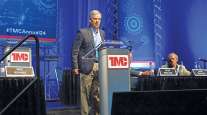More Electrification Firms Vie for Truck Stop Business
This story appears in the June 20 print edition of Transport Topics.
Truck stop electrification initiatives are proliferating again as four vendors try to convince more drivers to shut down engines and use the systems’ heating, cooling and Internet options to reduce emissions, costs and fuel use.
The most ambitious plans are being advanced by IdleAir, Knoxville, Tenn., which hopes to operate about 100 truck stop electrification, or TSE, facilities by the end of 2014. IdleAir, successor to similarly named IdleAire, would use technology developed by its predecessor, which went out of business in January 2010, swamped by mounting losses.
Convoy Solutions, a New York investment firm, bought the bankrupt IdleAire’s assets and renamed the business IdleAir. Before it closed, IdleAire dominated the market, building 134 locations with federal funds and borrowed cash, while other providers had fewer than 15. Today, three other companies — Shorepower Technologies, AireDock and CabAire — altogether operate a total of 25 facilities, with plans to add at least 60 more.
“Our idea is to continue to rebuild what we think are the best elements of the prior network,” said Mike Fielden, president of Convoy Solutions.
IdleAir, which began operations last year, now has 19 sites, primarily in the South, with plans for as many as 15 more this year.
CabAire, a unit of Control Module Industries, Enfield, Conn., added five new facilities in four Northeast states in the past year, director of marketing and sales Dan Shanahan told Transport Topics.
AireDock, a unit of Craufurd Manufacturing, Belchertown, Mass., has eight facilities open in five states, with plans to expand to 20 sites this year, the company’s statement said.
Both CabAire and AireDock use cab-connected hoses to deliver power.
Shorepower Technologies, Portland, Ore., will have two new facilities open before the fall to bring its total to 10, with plans to add 50 more, Vice President Alan Bates said.
Like IdleAir, Shorepower intends to build a network along main truck routes, including Interstate 5 in the West and Interstate 80 and Interstate 90 across the country.
“We are breaking new ground here,” Bates told TT. “We see our service evolving quickly, once there is a network.”
Shorepower uses a recreational-vehicle style plug-in that simply provides electricity for $1 an hour, an amount Bates said is similar to operating costs for an auxiliary power unit.
IdleAir is targeting key truck corridors in addition to the hot-weather states where it’s focused today, such as Interstate 70, Interstate 35, Interstate 81 and I-80, Fielden said. Its system uses a hose that is connected through the window to the tractor’s cab.
Fielden said IdleAir’s network can be more effective than its predecessor’s even though it’s smaller than IdleAire’s 130 facilities because the bankrupt company often had three or four locations within a 5-mile radius.
Ethan Garber, CEO of Convoy Solutions, also said IdleAir can at least double its predecessor’s peak of 100,000 users.
Owner-operators are being targeted by stressing IdleAir’s $2 per-hour cost for heating, cooling and Internet services — far less than the $4 to $5 an hour for idling, Garber said.
“We think the fleet market was underpenetrated,” Garber said — aiming to triple the number of fleet customers.
“We have the benefit of tremendous infrastructure and inventory,” Garber said, referring to the IdleAire installations’ overhead trusses and plug-in devices that give IdleAir the ability to use the existing equipment, with selective replacement of parts such as hoses that connect to the cab.
The trusses also can be a marketing tool, Garber explained, to display advertisements and make stops more visible because of the trusses’ height.
Although the number of new facilities has grown in the past year, there are some concerns.
“Even though drivers are penalized [for idling violations], they can save $4 a gallon, they protect their own health and reduce maintenance costs, those points collectively don’t drive high usage of TSE,” Shanahan said.
Usage also is being held down by wider use of auxiliary power units, battery-powered air conditioners and more in-cab climate control devices installed by original equipment manufacturers, Shanahan said.
“It’s a challenging business,” because of rising installation costs and increased requirements for matching funds from private companies in joint ventures with public agencies, Shanahan said.
“We think there might be increased use of the system once diesel hits $5 or $6 a gallon,” he said. “We are also hoping to see increased usage because of the location of the new sites.”
Three new CabAire sites are on key truck routes such as the New Jersey and Pennsylvania turnpikes and on Interstate 95 in Delaware. The others are at New Haven, Conn.’s port and in Smyrna, Del., on a route truckers use to avoid I-95 for north-south runs.
CabAire also is trying to combine TSE facilities with a network of electric-vehicle charging systems for cars such as the Chevrolet Volt on the theory that truckers mostly use the stations at night and car drivers will want to plug in during the day.


